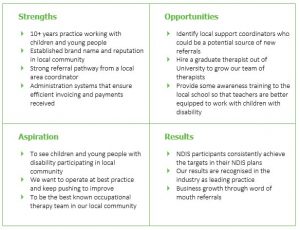Everyone has probably heard of a SWOT analysis, and most people have done one before. A SWOT can be a great way to quickly summarise many of the key issues that need to be considered in the strategy process.
In a SWOT, the strengths and weaknesses are looked at in terms of the organisation’s internal perspective. For example, what strengths and weaknesses are there with the organisation’s people, systems, technology, products/services, marketing and so on.
In my experience, many people and organisations think more highly of their strengths than they should. You might have a piece of software or a key person that you see as a strength, but wouldn’t the competitor down the road say the same thing about their organisation? Strengths need to be thought of in relation to competitors.
The opportunities and threats reflect external considerations. It might relate to growth opportunities in the market, new technology being developed, competitor actions or government policy changes, for example.
While simple to complete, a SWOT analysis can suffer from being too negatively focused on the Weaknesses and Threats. It can become about fixing what is wrong, rather than pursuing the opportunities and potential growth available.
CBB consultants recommend that organisations consider using a SOAR model instead of a SWOT analysis. We used this model when working with disability service providers to plan their transition to the NDIS. We have found that it encourages people to look past the immediate challenges to what can be in the longer term.
SOAR stands for Strengths, Opportunities, Aspirations and Results. The model removes such a heavy focus on the Weaknesses and Threats (which make up two of four elements, or half of the model), and focuses more on Opportunities aligned to the Aspirations.
The Aspirations part of the model also helps to provide a greater alignment to the organisation’s vision and purpose. The Aspiration and Results help people contributing to the SOAR to be more positive and future oriented.
We used the SOAR model with a disability services client recently to look at growth options for one of their business areas. In discussions about the model, we agreed to add a new element in to the model for the workshop which was the Constraints. The client wanted to document and consider both the internal and external Constraints that could stop them getting to the Aspirations and Results.
With this addition, we adapted the model to SOCAR. There was a suggestion from someone who thinks that acronyms used as management tools need to sound like a real word, and that the new element be Barriers, so that the model would be SOBAR!
Here’s an example of SOAR used with a local occupational therapist provider working with children or young people with disability.

We trust that this article has got you thinking more about the benefits of using the SOAR model instead of doing a SWOT because “that’s what we have always done”.
To make the learnings from this article more real, why not delay whatever you were planning on doing next just for 15 minutes and have a think about where your business is now. If you are like me, then pick up a pen and paper and put the four headings across an A4 page, or if you prefer, just open up a Word document and create a 2×2 table.
We’ve heard from many organisations at the moment that they are needing to review their current strategy as a result of the continually changing environment we find ourselves in with COVID-19. There’s never been a better time to stop for a few minutes and think about your strategy. I guarantee that the time spent writing this down now will provide some greater clarity for you in the priorities for coming weeks and months.
CBB has a number of consultants with experience in using different business modelling tools as part of the strategy development process. We could help you with the whole strategic planning process, or just to workshop one or a few elements like this.






